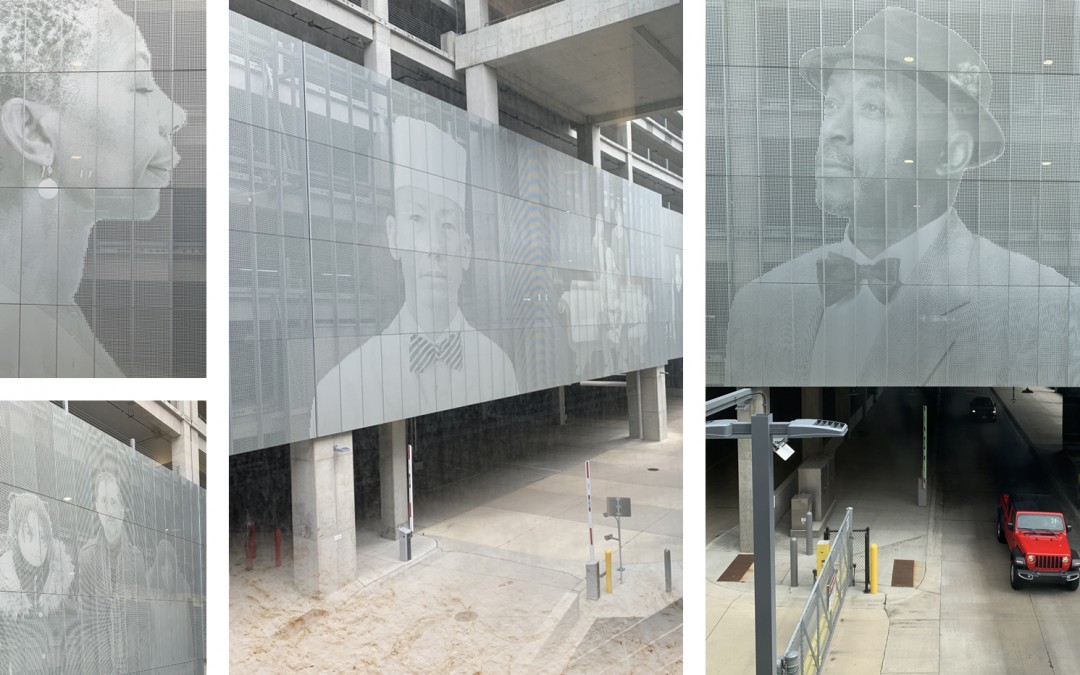With the freedom of an essayist (“We should all do, in the long run, what gives us joy,” says the master E.B. White), this writer is in leisurely contemplation today of the differences between a focused mind and a mind willing to wander, and the relationship of both to environment. The field of study is our Minneapolis-Saint Paul International Airport, where the tendency is towards purposeful, with a dash of harried. Got your bag? Your ID? Your offspring? Better focus!
There is another possibility. At our airport these days we can enjoy the sight of a large-scale abstract sculpture, or relish the color and sweep of a mosaic representing the Mississippi. Perhaps a different mindset is in order. Something like the difference between narrow and wide aperture? Or just the elasticity of time in which one moment you are rushing toward your journey and the next you’re sitting on that bench on the other side of security, glancing at your timepiece, which is, for the moment, on your side. Put that phone down and see your surroundings as something other than an impediment to making that plane. Now you can afford to look around.
Astute people at our airport are thinking beyond that basic dissonance and bridging it on our behalf. They are making a complex process work, and doing it through pandemic times, no less. Bravo!
Hurrah for the arts program at MSP airport, and its desire for your eye. Ben Owen, the director of Arts@MSP, calls its intention “surprise and delight”. Artist Kipp Kobayashi, who has a new piece coming, calls it “momentary respite.” Alan Howell, the senior architect for the Metropolitan Airports Commission, says “We put art in the spaces where people are.” This writer just says it’s wonderful.
Owen is an art appreciator, a master organizer, and an expert networker, whose mission, he says, is to transform space to place. Aspects of the work: conceive and install public artworks in an environment that in the raw could hardly be less artistic, for viewers that just might not be in the mood. Include long-term installations and rotating exhibits. Make the art un-generic and place-oriented. Choose work that allows interaction. Art in the terminals and on the concourses. Art on the parking ramps and in the restrooms. Overhead, underfoot. Lit and lively, and anchored by a signature piece that pierces both the departure and arrival levels, reminding us with shape and light that leaving and returning are part of the same journey. You are flying out of your home airport, and you will return home at travel’s end.
Lift up your eyes from your wheelie. Here are a few highlights, from this member of the traveling public.
The aforementioned signature piece, called The Aurora, with tech-responsive lake shapes embedded in the floor below. Yes, that is Lake Phalen among them and yes, you can jump on the lake. The colors above you change when you wave your arms at the “sky”.
Watch for many floor and wall mosaics, and a significant number of installations near the restrooms. See above “put art in the spaces where people are.” Take a look at restrooms on the retail mall, and at Gates C6 and F10.
Seek out the gallery in Concourse C, a spot where the airport’s electric carts used to be lined up to re-charge. Now it’s a rotating delight. Notice that many of the artists are local. Consider what a commission like this means to the artists, who are our neighbors. Think about reach. Forty million people pass through MSP every year.
And note especially Steve Ozone’s Interrupted Landscapes of the Incomer, nearly four hundred feet long, installed on the side of the Silver parking ramp, seen cinematically from the moving walkway between Concourses C and G. Ben Owen remembers that an Ozone installation was discussed at his very first staff meeting, and the conversation was tending toward large-scale flowers. “I asked him to consider something more representational and meaningful. I went to his studio and saw some of these portraits, which are of people who live in Northeast Minneapolis, as Steve does. People who came from elsewhere and chose Minnesota as their home.” In short, incomers. Ozone’s work here was inspired by his own family’s experience; his grandfather came to the U.S. from Japan in 1906. The MSP portraits are enormous and compelling, showing immigrants from Kenya, Syria, Mexico, Japan, Yugoslavia, Poland…and Jacksonville, Florida. Installed on pierced steel panels that somehow evoke pointillism, they are in more than heroic scale. At almost 16,000 square feet, the Ozone piece is the largest mural in Minnesota.
These artworks have sometimes been unveiled without fanfare (opening events have been postponed for some sixteen pieces installed during the pandemic, and identifying placards are yet to come), and yet they excel every day at their primary work. Catching the eye. Prompting a smile. Causing a pause. Lifting the gaze. Lodging in your perception. Perhaps even opening the heart. Just as public artworks ought to do.
Bravi tutti!






































